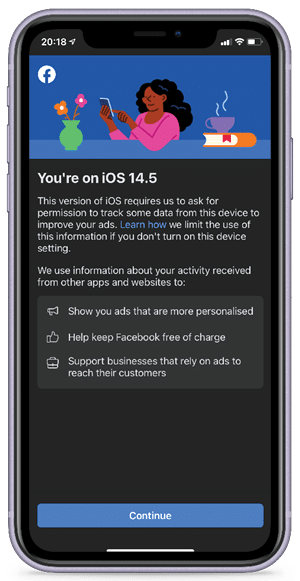How Apple’s new privacy feature will affect online advertising

New Media’s Head of Business Intelligence, Megan Singh, helps us understand the impact of App Tracking Transparency, introduced in iOS 14.5.
In recent years, consumers have become increasingly aware of user tracking across the internet. Now, a new feature introduced by Apple in iOS 14.5 has put the power back in the consumer’s hands, giving users more control over how developers and advertisers can track them across apps. This has sparked a massive battle in the digital realm, with Facebook at the tip of the spear. The social media giant argues that App Tracking Transparency (ATT) will prevent small businesses from understanding how effective their ads are.

Let’s look at the impact of ATT, and how businesses can still benefit from online advertising without sacrificing user privacy.
What is the business impact of the iOS 14.5 update?
The iOS 14.5 update impacts data-tracking permissions and, as a result, it impacts ad targeting.
Previously, any app downloaded from the iOS App Store was by default allowed to track user activity online. Ad networks cobble together this behaviour data to build user segments. Advertisers and brands, in turn, target these segments in their campaigns. Apple’s latest iOS update now prompts consumers to decide if they want to opt in or out of a particular app tracking their behaviour across other apps and websites.
Marketers and advertisers are anticipating the majority of consumers to opt out, which will lead to a dramatic decrease in the amount of user behaviour data they can gather. The knock-on effect is that advertisers won’t be able to serve personalised or hyper-targeted ads, generate quality leads, or accurately measure conversions. Ultimately, the biggest concern is that all of this will lead to advertising campaigns not being as effective and becoming more expensive.
How will Apple’s new privacy feature impact users?
Consumers can now make more informed choices about who they want to share their digital activity and behaviour with.
The iOS 14.5 update puts the power back in the consumer’s hands. Previously, the app developer was in the driving seat. The consumer could always opt out of being tracked, but they had to jump through a series of hoops, navigating through their device and app settings to turn off the tracking. Now the roles are reversed, and the app developer has to persuade the user to allow them to track their behaviour. The emphasis is on the consumer deciding whether or not to opt in.

Can businesses still benefit from online advertising without sacrificing user privacy?
Absolutely! But what advertisers first need to admit is that we’ve lost the trust of the consumer. Apple’s latest privacy update is part of a growing trend to protect and respect the consumer’s privacy. It’s not dissimilar to other data protection regulations such as GDPR in the EU, POPIA in SA, and the looming deprecation of third-party cookies. Once we’re able to admit that consumers have the right to protect their private and personal data, then we can lean into the privacy changes.
While trend spotters are predicting the resurgence of contextual advertising, advertisers need to start looking at publishers who have first-party data – information gained directly from consumers, which is more reliable than third-party data and device-based identifiers.
Facebook isn’t the only player out there. Yes, they are the biggest social media platform, but marketers need to start experimenting with other platforms and the growing number of options available.
In addition, Android devices are not affected by the Apple-only update, and Android still owns 84% of the mobile market in SA (Statista, January 2021).
It’s important to remember that the full impact of iOS 14.5 still remains unknown. AppsFlyer, a mobile adtech company, ran tests with early adopters, and they’re predicting that only 32% of consumers will opt in. But, at this stage, the consumer consent opt-in rate is largely unknown.

